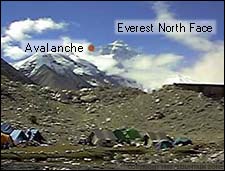|
Avalanche Swept Through Fixed Route Tuesday, September 9, 1997 On Monday a member of a Korean climbing expedition on the north side of Everest was swept to his death in an avalanche at 22,000 feet. Eight members of the team were following a series of fixed ropes leading up from the advance base camp (ABC) to a higher camp on the summit ridge when the incident occurred. The unidentified climber was at the rear of the group and reportedly noticed the avalanche with only enough time to alert his companions. Heavy snows during the previous several days had contributed to treacherous, unstable slopes on a mountain notorious for its severe conditions. Several international teams at ABC have combined their efforts in the last twenty-four hours to search for the Korean's body without success. Nearly sixty climbers from at least eight countries are attempting to summit Mt. Everest from the north (Tibetan) side this season in addition to several teams on the south (Nepalese) side of the mountain. The expeditions face a tiny window of opportunity between the just-ending monsoon season and winter, further narrowed by expiring permits, limited supplies, and illness.
Craig Calonica: It is too bad, as this accident was totally unnecessary. First of all, it had been snowing for about the last five days and there was deep snow deposited on the face. No one should go even close to that face until three or four days pass so it can settle or it slides off — whichever comes first. It is no secret that this is a very dangerous section, especially in fresh snow conditions and history has proven it. This area has claimed many lives, mostly to avalanches, and going in the area too soon as was the case here. The Colombians were very lucky to get away with it this time and hopefully they and everyone else will realize why this happened and will be a bit more patient in the future. One thing is for certain: you will never see me or my team close to that area until it has absolutely seen the proper settling time go by or it slides. Life is very short and we are very fragile and vulnerable to the conditions that exist here in the Himalayas. You will never experience a more intimidating and life threatening situation in your whole life until you come here — it is no place to practice haste.
MZ:
CC: — Craig Colonica, cybercasting for The Mountain Zone from Everest
|
[News Index] [Mountain Zone Home]

